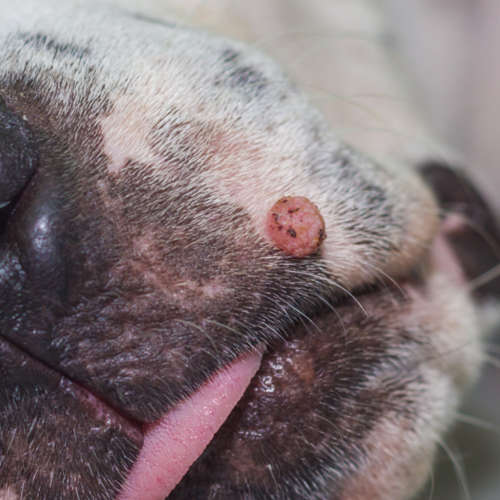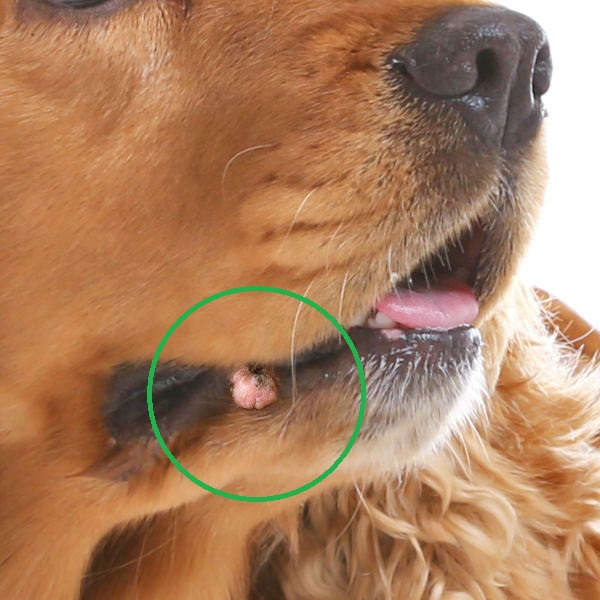
This article was updated on November 11th, 2023

It’s common for dog owners to come to my clinic with concerns about new pimples or red spots on their dog’s lips or mouth. Pink or red spots are quite prevalent and can occur at any age, although we usually see these growths in younger dogs.
When should I worry about a new red or pink spot on my dog’s lips?
A new red spot or pimple is something a veterinarian should look into further, especially if it is causing any bother or if it has been present for more than two weeks.
We become more concerned about a new lump if it is:
- Present for more than 1-2 weeks
- Fast-growing
- Ulcerated
- Causing the dog any issues
- On a senior dog: lumps that occur on older dogs are more of a worry than those we see in their younger peers
A pink or red bump on a dog’s lips could be a wide range of things, so let’s take a closer look at the top causes.
Most likely causes [with pictures]
1. A papilloma (wart)
If the dog is young, a wart is the top cause for new pink spots on dogs’ lips. These growths can come up seemingly overnight, and a dog may develop one or more. As well as being on the lips, we can also see them inside the mouth and on the skin.



These warts are spread by the papillomavirus and are not harmful. They should resolve over time. However, they are infectious—so you should avoid an infected dog having close contact with others, until their warts resolve. View more pictures of dog warts or find out how to remove a dog wart.
2. Canine acne
This is an inflammatory disorder that affects the lips and surrounding skin of dogs. We can see little pink and red bumps and pustules, which often cause the dog to itch and rub their face. As the condition progresses, we can even see facial swelling.

Some dogs are more genetically predisposed to this condition, including the Bulldog and Rottweiler. Your vet may take a culture of the skin, to see which bacteria are present. Treatment tends to consist of antibiotics, steroids and/or a medicated wash. Canine acne is a condition that can come and go and flare up at times.
View more pictures of dog acne & find out how to treat it.

3. A cancerous tumor
There is always the potential for a new growth to be a tumor, especially if we are dealing with an older patient or one who has had cancer before. Tumors can be a range of colors, including pink and red.
Some of the more common tumors we see that are these colors include a mast cell tumor or squamous cell carcinoma. View pictures of bumps and lumps in dogs.


4. A benign growth such as a histiocytoma
A histiocytoma can grow on or near the lip (as well as anywhere else on the body). It has the appearance of a blood blister and is harmless. It tends to occur in younger dogs. Many resolve spontaneously, without any treatment. View more pictures of histiocytoma & what to do.

5. An insect sting
If your dog has been stung, they may develop a red growth at the site of the sting. We can also see swelling and localized itchiness. If a stinger is visible, it is to be removed, and we can gently bathe the skin with salt water.

Call your vet to discuss the next step, which may include giving some antihistamines. Most dogs are back to normal by the next day.
6. A skin tag
Older dogs are prone to developing skin tags and warts, which have a fleshy appearance and are usually a light pink color. They typically grow slowly and cause no issues.
View more pictures of skin tags & learn what to do.

“It can be difficult to diagnose a new lump or bump on your dog just by looking at it. While your veterinarian may be able to identify if it’s a benign growth like a wart or an insect bite, it’s important not to mistake it for a cancerous tumor. To confirm what the bump is, your veterinarian will likely recommend doing a biopsy.”
A biopsy is the most accurate way to confirm a diagnosis, but it can cost anywhere from $150 to $500
Your vet will visually examine any lumps or bumps, drawing on their experience in order to help determine what is going on. If concerned at all, they would advise you to sample the lump. They can take a biopsy or a Fine Needle Aspirate (FNA), whereby a needle is directed into the lump, and some cells are aspirated and analyzed:
- An FNA can be done during a routine consult but is not always accurate enough to get us a diagnosis.
- Biopsies are able to provide more accurate answers but need to be taken under anesthetic.
Cost estimates
As a rough guide, an FNA is priced at about $150-200, while a biopsy is closer to $500 (learn more).
“The sooner a lip mass is addressed by a veterinarian, the sooner it can be cured. Time is especially of the essence if the issue is cancerous. It is much easier to remove a smaller mass.”
Treatment options will depend on what we are dealing with.
– For pink or red bumps like papillomas and histiocytomas, we generally take a ‘wait and see’ approach, as they should get better without intervention. Most papillomas resolve within 1-2 months, while a histiocytoma can take 2-3 months to disappear completely.
– A cancerous growth should be removed surgically, and the sooner this can be done, the better. In some cases, a dog would also be started on chemotherapy. The surgery to remove a lump on a lip depends on many factors, including the patient’s size and the size of the growth. We are usually looking at anything from $300-$1,000. If the lump is sent away for analysis, this will add about another $300 to the bill.
Is there anything I can try at home to help my dog?
When a lump or spot has only just appeared on your dog’s lips, keep an eye on it over the next few days to see if it goes down or goes away.
If your dog tolerates it, you should bathe the skin daily in salt water. In case there is a fluid or infection inside, you can apply a warm compress for 5 minutes at a time to draw it out.
Should the lump still be there in a week (the same size or larger), a vet check is indicated.
For dogs with mild acne, you could try wipes, like Douxo wipes, which can help to lower bacteria and yeast levels on the skin.
Related post:
Bumps and lumps on dog lips: what they are & what to do.
Disclaimer: This website's content is not a substitute for veterinary care. Always consult with your veterinarian for healthcare decisions. Read More.




Be the first to comment